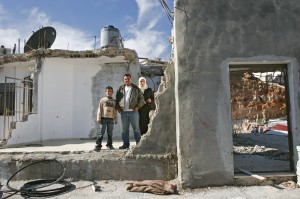The Jerusalem Post, September 11, 2009
It’s Friday afternoon in the West Bank village Bil’in. A crowd of protestors—Israeli, Palestinian, and international—is gathered at the barbed-wire separation fence. Facing the IDF on the other side, they chant in Hebrew, Arabic, English, and Spanish. Their voices are punctuated by the occasional pop of a tear gas canister launching into the air. Rapidly clicking camera shutters serve as quiet percussion.
But not all of these photographers are with the press. Some of them are with Activestills—a group that, like other photoactivists, attempts to bring provocative images to the attention of the Israeli mainstream.
Now a collective of ten photographers, Activestills began in 2005 with a few individuals who noticed each other documenting the same politically-charged events. “We all wanted to do something to promote the issues we believe in,” Keren Manor, one of the founders, recalls.
So they formed a group and started pasting their photographs, like those from Bil’in, on walls throughout Tel Aviv.
Using public space seemed a natural bridge between photography and activism. “There’s such a disconnect from the reality in the territories and the reality here. It’s not just that the public doesn’t know—it’s that they don’t want to know,” Manor says. “But by bringing images from the occupation to the street, we’re putting it in front of your eyes.”
Manor also explains that gallery exhibitions reach a narrow audience that might already be sympathetic to the issues. But for the price of printing one high quality photo, Activestills can instead print hundreds on paper and create a street exhibition. “And we don’t have to wait for the newspaper or media to pick up the story,” Manor adds.
In August of 2006, at the weekly protest in Bil’in, an Israeli attorney, Limor Goldstein, was shot twice in the head with rubber-coated bullets. “We called the media people but no one wanted the story,” Manor says, remarking that the press was preoccupied with the Second Lebanon War.
Activestills publicized the incident by plastering posters of a bloodied Goldstein, who survived but sustained lasting brain damage, on walls in Tel Aviv. “We’re taking direct action,” Manor says, “we’re not waiting for a mediator.”
And because the collective is self-funded, they are free to focus on the topics they feel are the most pressing.
Activestills’s most recent street exhibition centered on migrant workers and African asylum-seekers, hundreds of whom were arrested in July as the newly-formed Oz unit swept through South Tel Aviv. Some of Activestills’s images were wheat-pasted onto the spots where laborers and refugees were accosted by immigration police.
In 2007, Activestills marked 40 years of occupation with a street exhibition that included images from the Bethlehem, Hebron, East Jerusalem and Gaza, obtaining images from photojournalists in the Gaza Strip. During Operation Cast Lead, Activestills coordinated again with the same photographers to bring images to public spaces in Tel Aviv. “We are collaborating towards the same goal,” Activestills member Oren Ziv remarks.
What is the aim?
Manor responds, “We are acting against any kind of repression, racism, and exploitation.”
Ziv adds, “There is no difference to us between Jewish people who are kicked out of their homes in Tel Aviv and Palestinians who are kicked out of their homes in Hebron. It’s one big struggle.”
***
Sadiq Ismail is a 15-year-old refugee from Darfur. An unaccompanied minor, he lives in a shelter in South Tel Aviv with other asylum-seekers. Too young to receive a visa, Ismail is on a quest for legal recognition and help.
Ismail is one of the dozen teenaged African refugees included in “Asylum City”, an Activevision-produced documentary. As the name suggests, Activevision is an offshoot of Activestills. But “Asylum City” wasn’t filmed by activists—the cameras were left in the subjects’ hands.
“It was a huge outlet for the kids,” Activevision member Daniel Cherrin says. Cherrin is a co-founder of Fugee Fridays, a volunteer initiative that assists asylum seekers from war-torn regions of Africa, and he played a pivotal role in “Asylum City” by conducting short videography courses for the teenagers.
Shaping their own stories also helped the refugees see their circumstances in a new light, Cherrin explains. “It’s empowering. It makes their situation seem manageable.”
The audience also gets a unique view. “The kids are telling about their lives from their perspective—it’s not about what some journalist or filmmaker thinks,” Cherrin remarks.
“Asylum City” has been screened in Tel Aviv, New York City, and several cities in Germany. According to Cherrin, audiences are troubled by what they see. And they are curious about the Israeli government’s role in the picture. “[The documentary] creates a lot of questions,” he says, “and pulling the questions out of people is a huge part of photoactivism.”
The camera serves another purpose, Cherrin adds. It reminds people—and states—that they are responsible for their actions.
But Israel isn’t the only country that falls under Cherrin’s scrutinizing lens. Alongside two young academics, Cherrin is currently working on an independent documentary about the Bedouins in both the Negev and Sinai.
“The unrecognized villages in Israel are a human rights’ disaster,” he says, hastening to add that life is equally difficult for Egypt’s Bedouins. “In Egypt, it’s a conflict between the people of the land and the state of the land—the government is disenfranchising them.”
Occasionally, this tension boils over into violent clashes between the Bedouin and Egyptian police.
Cherrin has yet to personally witness such a confrontation. But he gave a half-day tutorial and a camera to a 26-year-old Bedouin woman who lives on a hotly contested piece of land. “As we speak, she’s documenting,” Cherrin says. “She’s getting involved and becoming an activist.”
